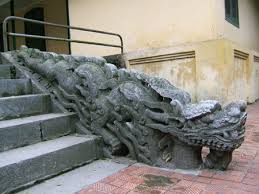Archaeologists have found in Co Loa Commune cut and polished pebbles quite similar to those found in Lao Cai, Nghe An and Ha Tinh Provinces. These pebbles are remnants of cutting and grating tools used by primitive men in the Paleolithic period, some 20,000 years ago.

The Paleolithic was followed by the period of glacier melting and sea level rising. The last sea transgression took place 17,000 years ago. As a result, the Hanoi area was submerged and both animals and human beings had to retreat to the hinterland and mountains. Thus, for almost the entire Neolithic period – some 6,000 to 10,000 years ago – this area was uninhabited. At the end of this period, in the wake of sea recession, the Hanoi area became marshes swamps, and dense forests. Thereupon, men began settling in this area.
Archaeologists have found a series of artifacts and relics that testify to a continuous evolution from the early Bronze Age to the Iron Age, some twenty centuries BC. According to them, Hanoi had experienced four cultures; Phung Nguyen (4000-3000 years ago), Dong Dau (3500–3000 years ago), Go Mun (around beginning of the first millennium BC), and Dong Son (from the middle of the first millennium BC to the early Christian era).
The local inhabitants were engaged in the cultivation of food crops (mainly paddy, and then beans and sweet potatoes), fruit trees (such as custard apple, canarium, and sugar cane), in animal husbandry (mainly buffaloes, oxen, pigs, goats, dogs, chickens), fishing and hunting. These activities are evidenced by archaeological findings: bronze plough shares, spades, scythes; seeds of custard apple and canarium, burnt paddy seeds and rice husk; stone and bronze axes, bronze knives and arrows; stone and terracotta weights attached to fishing nets.
This period roughly coincided with that of the Hung Kings, as narrated by legend. While the presence of this Dynasty is still subject to further scientific proof, the struggle led by King Thục Phan against the Chinese Qin invaders is a historically acknowledge fact. In 218 BC, Emperor Qin Shi Huangdi of China dispatched a 500,000-troop army to subjugate the Bach Viet land. The Viet, led by Thuc Phan, put up strong resistance, taking advantages of the dense forests and high mountains. Major losses that the Qin had suffered over 10 years of war compelled them to withdraw. In 208 BC, Thuc Phan replaced the Hung King in ruling the country, which he named Au Lac. The Capital of Au Lac Kingdom was located in Co Loa (presently, Dong Anh District, 15km north of Hanoi’s downtown) where a spiral-shaped citadel was built. Hanoi thus became the political, economical and cultural center of the country.
When King Thuc Phan reigned the country from 208 BC to 179 BC, by means of a cunning strategy, Zhao To, a general of the Han Dynasty (China), succeeded in defeating him. After that, Au Lac Kingdom fell under Chinese feudal rule for one thousand years.
Source: Hanoitimes